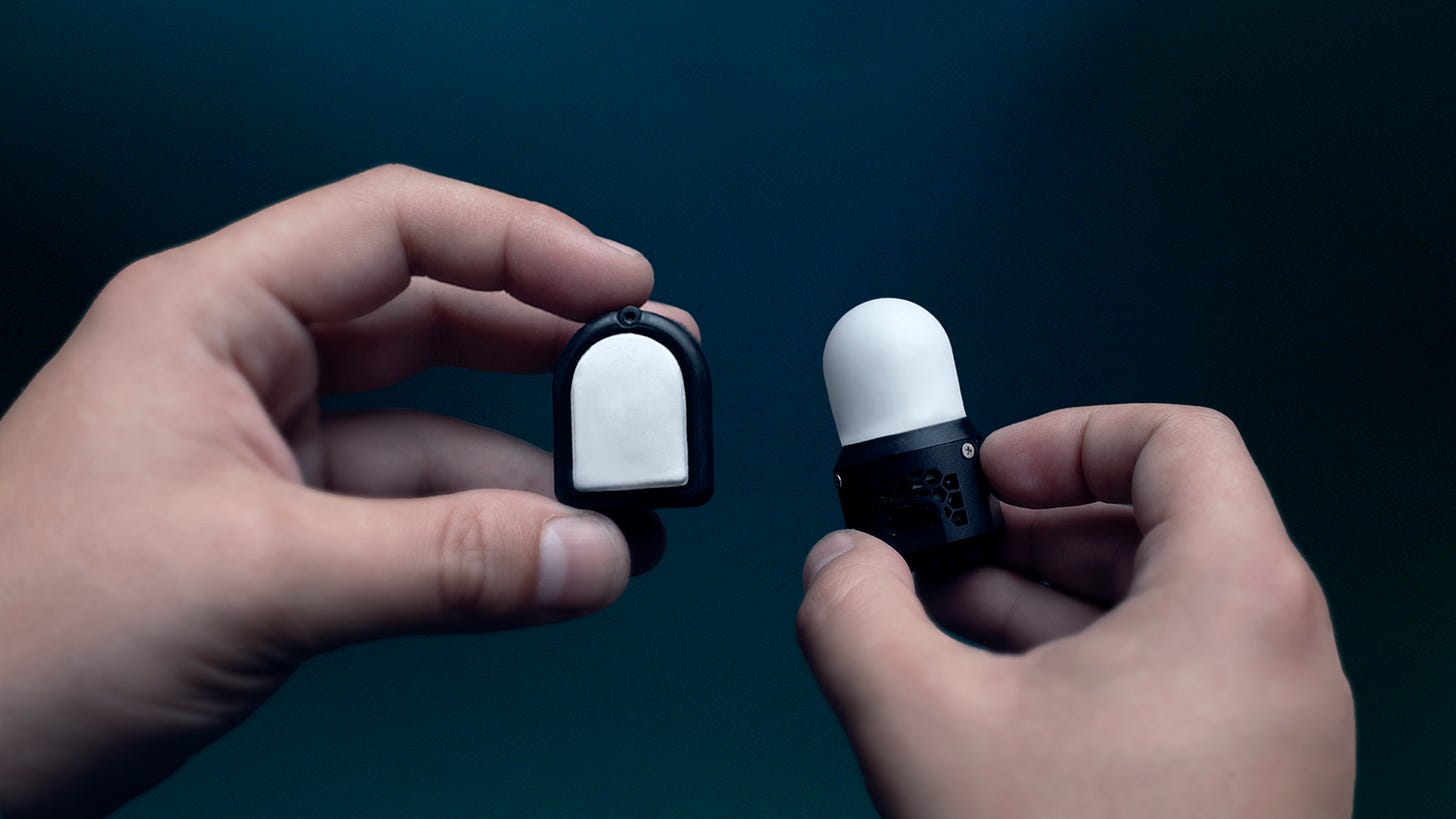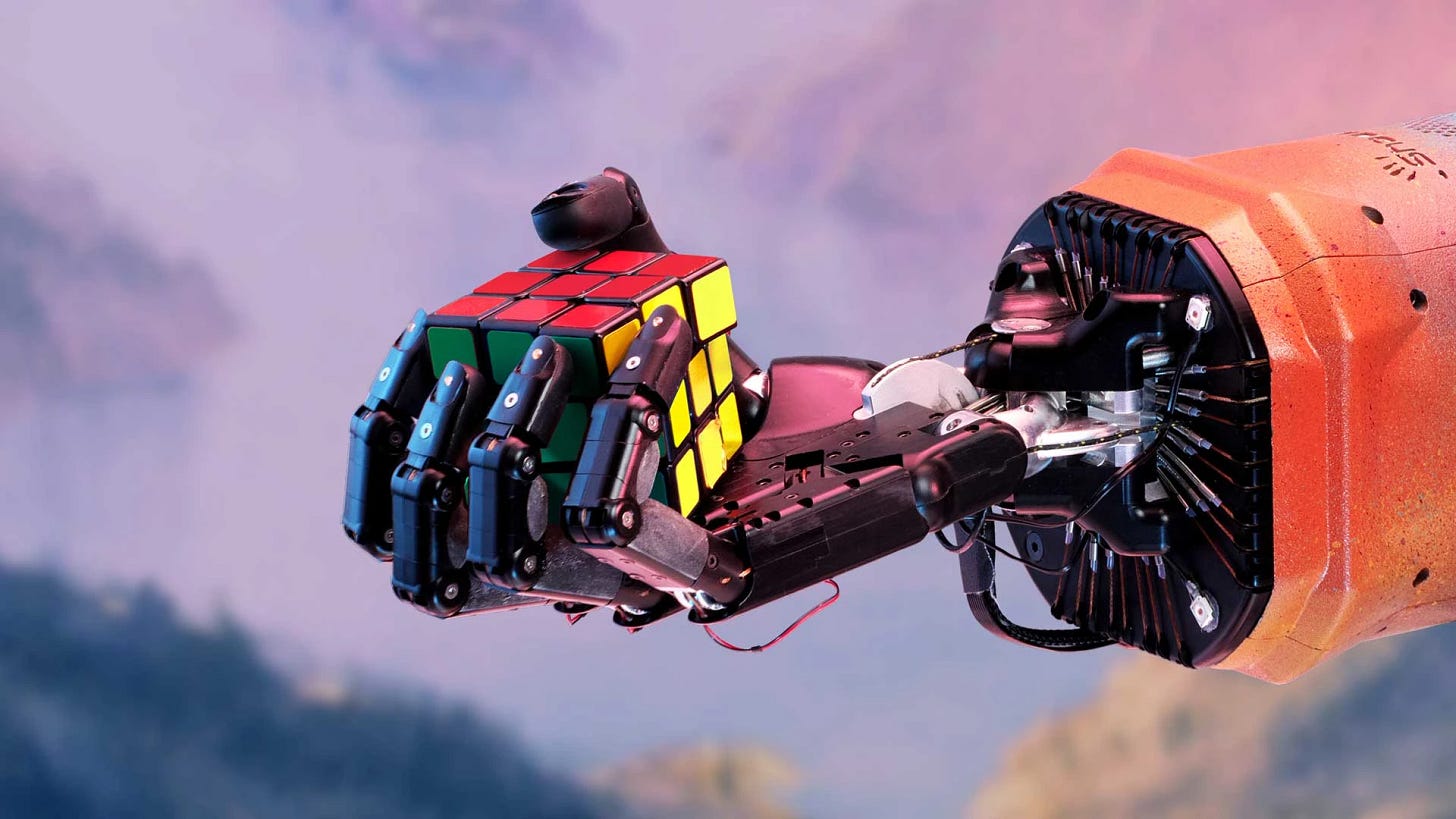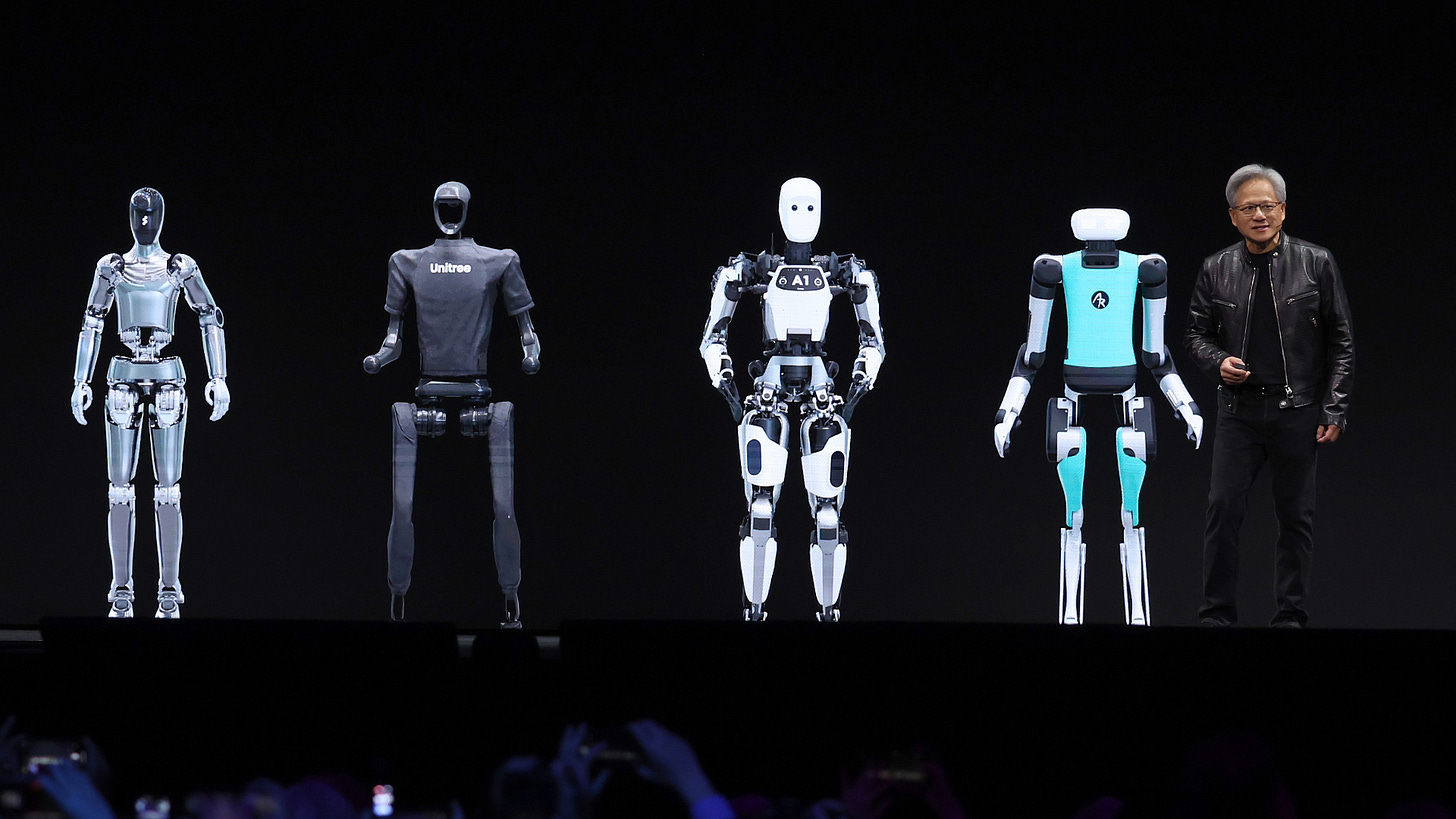Robotics is the new AI - Sync #492
Plus: OpenAI's and Google's new models leaked; the state of robotic investments in 2024; pest control with CRISPR; drone with a flamethrower; 81-year-old biohacker trying to reverse ageing; and more!
Hello and welcome to Sync #492!
The tech industry is always on the lookout for the next big thing. Over the past two years, AI has been that big thing. But what will come after AI? This week, we take a closer look at how big tech companies view robotics as the next frontier.
In other news, OpenAI’s and Google’s new models have leaked. Meanwhile, Nvidia rides the AI wave to become the world’s largest company by market capitalization, OpenAI reportedly strikes a deal with Broadcom and TSMC to build its own AI chips, and also acquires the Chat.com domain.
Over in the robotics, we have a report on the state of robotics investments in 2024, a flamethrower attachment for drones, and the news of Amazon securing FAA approval for its new delivery drone as it begins tests in Arizona.
We also have a story about an 81-years-old biohacker who spends $70,000 a year trying to reverse ageing, explore how CRISPR is used in pest control and highlight a research that created plant-animal hybrid cells that can photosynthesize and derive energy from sunlight.
We wrap up this week’s issue of Sync with Marques Brownlee testing Meta’s Orion and Snapchat’s AR Spectacles, and speculating what a post-smartphone augmented reality future could look like.
Enjoy!
Robotics is the new AI
For almost two years now, AI has been the hottest trend in tech, attracting billions in investments, spawning new startups, and elevating some companies while bringing down others. However, the tech industry is always searching for the next big thing, and robotics might be that next frontier after AI.
Amazon placed a significant bet on robotics when it acquired Kiva Systems twelve years ago, a move that laid the foundation for Amazon Robotics. This investment has paid off massively. Today, nearly a million robots operate in Amazon warehouses, moving boxes, packing orders, and sometimes even delivering them. This robotic workforce enables Amazon to fulfill orders more quickly and saves the company billions of dollars. I wrote more about robotics at Amazon in this article here.
How robots are building Amazon's future
Ordering on Amazon is simple: just click 'Buy Now,' and the next day your items are delivered. Behind the scenes, Amazon finds the item you ordered from the warehouse closest to you and sets in motion a complex logistical system that is invisible to the customer, involving not only thousands of people but also a growing number of robots.
Recently, other big tech companies have begun to more seriously explore robotics as a potential new market. Advances in prototyping technologies, manufacturing, batteries, electronics, and material science have all contributed to lowering the costs of designing and building robots. However, what has truly propelled robotics to a new level are advancements in AI, and that’s where companies like Google and Nvidia see their opportunity.
Google DeepMind has published numerous papers this year detailing the outcomes of their research. The AI lab has been focusing on foundational and generative models specifically designed for use in robotics, as well as models aimed at improving robot dexterity. They have also shared some fun projects, such as teaching small robots to play football (or soccer, if you’re in America) and making robots play table tennis against humans.
Meanwhile, Nvidia clearly views robotics as the next big thing after AI. This year, Nvidia CEO Jensen Huang has been ending his keynotes by standing next to a projection featuring numerous humanoid robots and even inviting real robots onto the stage. What connects these machines is that they were all built using Nvidia’s hardware or software.
On the software side, Nvidia provides a comprehensive platform for robotics, offering tools and AI models to develop, train, simulate, deploy, operate, and optimise robotic systems and their software. Once these models are trained on Nvidia’s GPUs in virtual environments, they can be transferred to real physical robots, which also run on Nvidia’s hardware, such as Jetson—a family of compact computers designed for robotics and edge computing.
Another company that has taken an interest in robotics research is Meta. Last week, Meta’s AI research team published the results of their work on touch perception, robot dexterity, and human-robot interaction. The researchers introduced Meta Sparsh, a general-purpose touch representation for vision-based tactile sensing that uses self-supervised learning to function across multiple sensors and tasks without requiring labelled data. They also unveiled Meta Digit 360, an artificial fingertip developed in collaboration with GelSight Inc., which is capable of detailed touch perception and detecting fine forces, and Meta Digit Plexus, a standardised hardware-software platform for integrating tactile sensors into robot hands to improve coordination and dexterity. The researchers hope that Sparsh, Digit 360, and Digit Plexus will help robots better perceive the world and find applications in robotic hands or prosthetics.

Additionally, researchers at Meta released the Planning And Reasoning Tasks in humaN-Robot (PARTNR) benchmarks, a new tool for evaluating human-robot collaboration. PARTNR is designed for large-scale assessments and is based on the Habitat 3.0 simulator, allowing for the testing of AI models in household tasks and collaborative scenarios. The PARTNR benchmark aims to enhance AI models' ability to collaborate effectively with humans, addressing challenges such as task coordination and recovery from failures.
And lastly, there is OpenAI. OpenAI is now famous for its GPT family of large language models. However, before the lab shifted its focus to LLMs, it was actively experimenting with robotics. The most known result of OpenAI’s robotics research was an AI model that solved a Rubik’s Cube using a robotic hand. The lab also had other robotics projects, such as Roboschool, an open-source software for robot simulation.

However, robotics proved to be too challenging to tackle without sufficient data, and in 2021, OpenAI disbanded its robotics team. Now, after the massive success of ChatGPT and billions of dollars in investments, OpenAI is returning to robotics research. In May this year, OpenAI relaunched its robotics unit and recently hired Meta’s former Orion head to lead its robotics and consumer hardware initiatives. Maybe this time, the investment in robotics research will pay off.
Beyond research, OpenAI has been investing in robotics startups, such as Figure, 1x or Physical Intelligence. It is also worth noting that one of OpenAIs technical goals is to build a household robot.
The convergence of hardware and software advancements, particularly in AI, has led some to believe that we are on the brink of a "ChatGPT moment" in robotics—an application of robotics that shifts the scales and transforms the world. While many speculate that humanoid robots could drive this breakthrough, we shouldn’t overlook the millions of robots already moving boxes in warehouses or the vast array of industrial robots in factories around the globe. There are also drones, autonomous delivery robots navigating sidewalks, and affordable robotic arms that are transforming small businesses.
The future of robotics is exciting. Big tech companies see that and don’t want to miss out on this opportunity.
If you enjoy this post, please click the ❤️ button or share it.
Do you like my work? Consider becoming a paying subscriber to support it
For those who prefer to make a one-off donation, you can 'buy me a coffee' via Ko-fi. Every coffee bought is a generous support towards the work put into this newsletter.
Your support, in any form, is deeply appreciated and goes a long way in keeping this newsletter alive and thriving.
🦾 More than a human
This 81-year-old 'biohacker' spends $70,000 a year trying to reverse aging
Meet Kenneth Scott, an 81-year-old biotech investor who spends approximately $70,000 annually on personal treatments and invests $500,000 to $750,000 in biotech companies focused on anti-ageing. Scott claims to have the biological age of an 18-year-old and attributes his youthful appearance and energy to a range of experimental treatments, including a plant-based diet, platelet-rich plasma facials, amniotic exosome injections, anti-ageing peptides, and other therapies. Experts caution against seeking treatments abroad that are unapproved by the FDA, as these may not meet rigorous scientific standards. Scott, aware of these risks, prioritises immediate results over regulatory approval, citing his limited life expectancy as motivation to pursue these treatments regardless of regulations.
🧠 Artificial Intelligence
Alexa’s New AI Brain Is Stuck in the Lab
This article from Bloomberg takes us behind the scenes at Amazon and its Alexa labs, which are busy developing a new, updated AI assistant powered by generative AI. The first version of the AI-enhanced Alexa was presented to Amazon CEO Andy Jassy in 2023, but the project encountered challenges, delaying the rollout of the updated AI-driven Alexa until 2025. This is a story of another big tech company that, like Google, was caught off guard by the rapid rise of OpenAI and ChatGPT, and now must catch up instead of leading in the AI assistant space as it did when Alexa was initially released and was synonymous with AI assistant for millions of people.
OpenAI builds first chip with Broadcom and TSMC, scales back foundry ambition
According to Reuters, OpenAI is building its first AI chip in partnership with Broadcom and has secured TSMC for manufacturing. Broadcom reportedly assists OpenAI's chip team in designing AI chips for inference, which are expected to be ready in 2026, although this timeline may change. Additionally, Reuters reports that OpenAI has started adding AMD chips to its lineup alongside Nvidia chips to diversify supply and reduce infrastructure costs.
Nvidia Rides AI Wave to Pass Apple as World’s Largest Company
Nvidia has done it. On Tuesday, its market capitalization reached $3.43 trillion, surpassing Apple at $3.38 trillion, making the chip manufacturer the most valued company in the world. Nvidia now accounts for 7% of the weight of the S&P 500 Index and is responsible for approximately a quarter of the benchmark’s 21% gain this year.
OpenAI’s o1 model leaked on Friday and it is wild — here’s what happened
Last week, a number of users managed to access the full version of OpenAI’s o1 reasoning model by changing a URL parameter. OpenAI confirmed that an issue occurred during preparations for limited external access, which has now been resolved. While OpenAI was busy patching their website, users discovered that the full o1 model can reason over images and solve complex image puzzles. After analysing the responses from the o1 model, some speculated that the preview versions were based on earlier GPT models, while the full o1 model had been trained from scratch.
Google's Jarvis AI extension existence leaked on the Chrome store
It seems that Google’s Jarvis AI extension has leaked on the Chrome Web Store. According to the Chrome Web Store page, Jarvis is described as “a helpful companion that surfs the web for you.” The tool operates by analyzing screenshots and running them through Gemini 2.0, Google’s new AI model speculated to be released in December, to determine what actions to take, similar to Anthropic's Claude Computer Use and Apple Intelligence’s “onscreen awareness.”
Robert Downey Jr: ‘I will sue all future executives who make AI replicas of me’
Robert Downey Jr. stated that he intends to have his lawyers sue future executives who attempt to create AI-generated digital replicas of him without permission. He humorously mentioned that even after his death, his law firm would continue to pursue such cases. Downey’s statement comes at a time when many actors are concerned that movie studios may use AI to recreate their likenesses without consent or compensation, which was one of the reasons why actors went on strike last year.
OpenAI acquired Chat.com
OpenAI bought the Chat.com domain, which now points to ChatGPT. Although OpenAI did not disclose the purchase price, the domain was previously owned by HubSpot co-founder and CTO Dharmesh Shah, who bought it for $15.5 million last year. In a tweet, Shah confirmed he sold the domain to OpenAI and hinted that he had been paid in OpenAI shares.
Arcade, a new AI product creation platform, designed this necklace
I think we are at the point in the AI revolution where we start to see creative AI startups that go beyond being just chatbots. One of them is Arcade, a marketplace where users can design custom jewellery using generative AI, which is then crafted by Arcade’s artisans. Additionally, users can profit from their designs by earning a 2.5% commission on sales if they meet certain requirements. Arcade plans to expand beyond jewellery into categories such as accessories, apparel, and leather goods, competing with similar platforms like Off/Script. To support this growth, the startup has raised $17 million in funding, backed by investors such as Ashton Kutcher, Reid Hoffman, Colin Kaepernick, and Karlie Kloss.
From Naptime to Big Sleep: Using Large Language Models To Catch Vulnerabilities In Real-World Code
Researchers from Google present Big Sleep, a collaboration between Google Project Zero and Google DeepMind, focused on AI-assisted vulnerability research. In this post, researchers share how Big Sleep discovered a real-world, exploitable vulnerability in SQLite, a widely used open-source database engine. This discovery is notable as it represents the first public instance of an AI agent finding a previously unknown memory-safety vulnerability in well-used real-world software and shows the potential AI can have in cybersecurity.
NotebookLlama
I like Meta’s approach to AI. It is almost exactly the same as that of other big tech companies. The difference is that their projects are often available on GitHub, such as NotebookLlama, an open-source equivalent of Google’s NotebookLM, that you can download and run from your computer.
If you're enjoying the insights and perspectives shared in the Humanity Redefined newsletter, why not spread the word?
🤖 Robotics
Amazon gets FAA approval for new delivery drone as it begins tests in Arizona
Amazon has received approval from the FAA to fly its new MK30 delivery drone beyond the visual line of sight and over longer distances. The company plans to begin test deliveries in Tolleson, near Phoenix, Arizona, where Amazon is integrating Prime Air with its logistics network. Previous test operations were conducted in College Station, Texas, and a test site in Lockeford, California, which was shut down.
From surge to sobriety: the state of robotics investment in 2024
The Robot Report features a report on the state of robotics investments in 2024. According to the report, the robotics investment landscape, after a decline starting in 2022, is showing signs of recovery in 2024, driven by falling component costs and advances in AI. Investment is particularly strong in autonomous vehicles, humanoid robots, and vertical robotics, with significant funding going to late-stage rounds, while early-stage funding remains limited. The full report is available here.
First artwork by humanoid robot sells for over $1.0 million
A portrait of Alan Turing, painted by Ai-Da, the world’s first ultra-realistic robot artist, became the first artwork by a humanoid robot to be sold at auction, fetching $1,084,800 and significantly surpassing the pre-sale estimate of $180,000 at Sotheby’s Digital Art Sale.
WASP Flamethrower Drone Attachment
Throwflame, a company that previously attached a flamethrower to a four-legged robot, now offers a flamethrower attachment for drones. The company says that this attachment, which can deliver up to 100 seconds of continuous fire, is ideal for clearing debris from power lines, pest management and nest elimination, forest fire containment, or remote agricultural burns.
Forerunner K2 humanoid robot can carry 33 lb in each dexterous hand
Chinese robotics company Kepler unveiled the fifth iteration of their Forerunner K2 humanoid robot. The robot features an 8-hour battery life, proprietary AI, in-house actuators, and sensor-equipped human-like hands capable of handling up to 25 kg (55 lb). Currently in a testing phase, the robot targets intelligent manufacturing, warehousing, logistics, high-risk operations, research, and education.
▶️ DR01 Humanoid Robot Outdoor Test (0:38)
Another week, another video of a humanoid robot doing things. This time, it is from the Chinese company DEEP Robotics, showcasing how their humanoid robot DR01 handles various terrains and obstacles.
🧬 Biotechnology
Pest control gets the CRISPR treatment
New genetic engineering methods, such as the precision-guided sterile insect technique (pgSIT), are opening new possibilities for controlling agricultural pests and disease-transmitting mosquitoes. Companies like Agragene, Synvect, and Oxitec are developing these methods, with some already conducting trials in regions such as the US and Brazil, offering environmentally friendly alternatives that avoid chemical pesticides and target specific pests without harming beneficial insects.
World’s 1st cloned ferret gives birth to healthy kits in a conservation milestone
A cloned black-footed ferret named Antonia has successfully given birth to two healthy kits, marking the first reproduction by a clone of an endangered US species. Antonia was cloned using the DNA of Willa, a black-footed ferret with unique genetic diversity, preserved since 1988 at the San Diego Zoo’s Frozen Zoo. Antonia was not the first clone; the first, Elizabeth Ann, was born in 2020 but could not reproduce due to health issues. Further cloning efforts led to Antonia and other clones, which could improve the genetic health and resilience of the current ferret population.
Plant-animal hybrid cells make solar-powered tissues, organs or meat
Japanese scientists have created hybrid plant-animal cells by inserting chloroplasts into animal cells, enabling the animal cells to photosynthesize and derive energy from sunlight. The chloroplasts continued to perform photosynthesis for up to two days inside the animal cells, marking the first documented instance of photosynthetic electron transport in chloroplasts functioning within animal cells. These hybrid cells could revolutionise tissue engineering and help in growing cells for lab-grown meat, artificial organs, and skin sheets.
💡Tangents
▶️ I Tried Real Augmented Reality Glasses (20:28)
In this video, Marques Brownlee shares his experience of trying out two prototype augmented reality glasses—Meta’s Orion and Snapchat’s AR Spectacles. Marques showcases the demos prepared by both companies to highlight their prototypes, explains how these devices are built and explores what a post-smartphone augmented reality future might look like.
Thanks for reading. If you enjoyed this post, please click the ❤️ button or share it.
Humanity Redefined sheds light on the bleeding edge of technology and how advancements in AI, robotics, and biotech can usher in abundance, expand humanity's horizons, and redefine what it means to be human.
A big thank you to my paid subscribers, to my Patrons: whmr, Florian, dux, Eric, Preppikoma and Andrew, and to everyone who supports my work on Ko-Fi. Thank you for the support!
My DMs are open to all subscribers. Feel free to drop me a message, share feedback, or just say "hi!"








